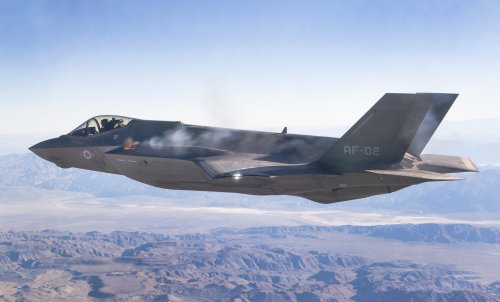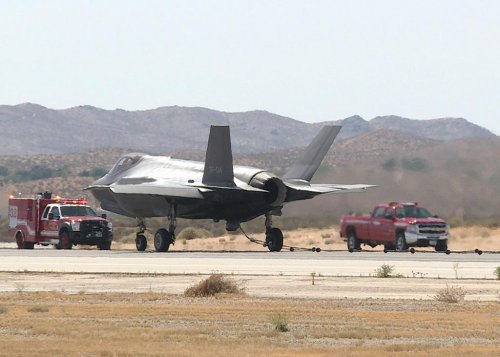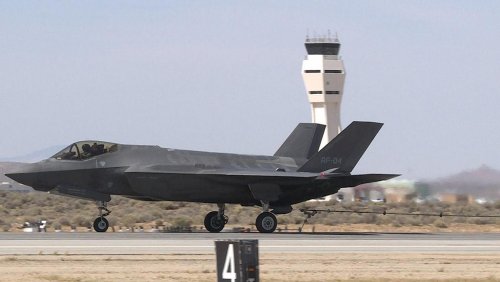Perhaps the most significant issue facing the program over the next two years lies with something that has dogged it for at least a year, since Air Force Maj. Gen. Jeffrey Harrigian, head of F-35 integration, told me in his first interview about it: It’s development of the mission data files or “threat library.” The data on missile launches, frequencies, opponents’ weapons and their sensors come from the Intelligence Community (IC). The Office of Secretary of Defense’s Intelligence Mission Data Center gathers the data from across the IC. Then the $300 million United States Reprogramming Laboratory at Nellis Air Force Base turns that information into threat data for all three versions of the F-35, as well as for its international partners. (That lab will be joined by three more over the next few years, Bogdan said this afternoon.)
This looks like a case where someone simply goofed. “Despite a $45 Million budget provided to the Program Office in FY13, the required equipment was not ordered in time and the USRL is still not configured properly to build and optimize Block 3F Mission Data Files (MDFs). The program still has not designed, contracted for, and ordered all of the required equipment – a process that will take at least two years for some of the complex equipment – after which significant time for installation and check-out will be required,” Michael Gilmore, the head of Operational Testing and Evaluation, said in prepared testimony. When I asked him about this, Bogdan confirmed the situation: “He is right that we didn’t buy this in time.”
Does this really matter? Yes. Gilmore put it simply in his written testimony: “If the situation with the USRL is not rectified, U.S. F-35 forces will be at substantial risk of failure (emphasis added) if used in combat against these threats.”
http://breakingdefense.com/2016/04/mccain-lays-down-law-on-f-35-bulk-buy-kendall-says-it-works/?__hstc=174454333.38a449bbbdcb84d6f43651b42a28a6bb.1461771412330.1461771412330.1461771412330.1&__hssc=174454333.1.1461771412330&__hsfp=3050592305
Improving F-35 Software Reliability
—BRIAN EVERSTINE4/27/2016
The F-35 Joint Program Office has seen a dramatic increase in the stability of its Block 3i software, which previously caused the jet’s radar to regularly shut down. Pilots flying an earlier version reported a difference in “nanoseconds” of communication between the radar and the jet’s computer, prompting it to shut off once every four hours, Program Executive Officer Lt. Gen. Christopher Bogdan said. In the past month, test aircraft have flown 44 sorties with a total of 96 flight hours on updated software, and reported 15 hours between stability problems, Bogdan said following a Senate Armed Services Committee hearing on Tuesday. A team of contractors from Lockheed Martin, Northrop Grumman, and BAE Systems got into the “nitty gritty” of the software to determine bugs and find fixes. The program office expects to make a decision this week on whether this is the right version of the software to go forward with as the Air Force looks to reach initial operational capability later this year.
http://www.airforcemag.com/DRArchive/Pages/2016/April%202016/April%2027%202016/Improving-F-35-Software-Reliability.aspx
F-35 OT&E Slipping Away
—JOHN A. TIRPAK4/27/2016
Operational, test, and evaluation of the full-up F-35 will be a minimum of six months behind schedule, though it most likely will be a year late because of a number of issues still vexing the program, Pentagon operational, test, and evaluation director J. Michael Gilmore told the Senate Armed Services Committee Tuesday. Among the issues he thinks will delay OT&E are software instability, “shortfalls” in electronic warfare and electronic attack capability, missile launch warnings as detected by the Digital Aperture System, unacceptably long times needed to complete aerial refueling—“two to three times as long as other aircraft,” classified mission system problems, “gun problems on all variants,” and the Autonomic Logistics Information System. The Air Force F-35A version was supposed to go through IOT&E in October 2017, but now likely won’t enter the test phase until May of 2018, Gilmore said. He said his office will be thorough and make sure the F-35 can do everything it’s supposed to, and wants it to work. “If the F-35 doesn’t succeed,” Gilmore said, “we’ll be in a pickle.” Program Director Lt. Gen. Christopher Bogdan told the panel he is almost ready to certify that the instability issue is fixed. It will shortly be “behind us,” he said.
http://www.airforcemag.com/DRArchive/Pages/2016/April%202016/April%2027%202016/F-35-OTE-Slipping-Away.aspx
Go Ask ALIS
—JOHN A. TIRPAK4/27/2016
It’s almost certain the Air Force will declare initial operating capability with the F-35A closer to Oct. 1 than the long-planned Aug. 1 target date. Top Pentagon acquisition, program, test, and audit officials told members of the Senate Armed Services Committee on Tuesday the F-35’s Autonomic Logistics Information System is the sole culprit for the probable delay. The government-operated ALIS needs to be able to talk with the computer systems of both Lockheed Martin, which builds the F-35, and Pratt & Whitney, which makes its F135 engine, and doing that has been a challenge, particularly given the need to maintain cyber protections at all levels, program director Lt. Gen. Christopher Bogdan said. “All is on track for 1 August 16,” Bogdan said—noting that Hill AFB, Utah, will likely have the necessary jets and maintainers in place by then, “except for ALIS,” which he said is “probably 60 days behind.” Pentagon acquisition chief Frank Kendall said it’s the Air Force that will decide what minimum capability it deems “acceptable” for IOC, but he said he suspected that, like the Marine Corps, USAF won’t declare IOC unless it’s “comfortable” the jet will work as expected with the 3i software package. Both Bogdan and Kendall agreed that F-35 IOC will certainly happen before the mandatory December deadline, noting that August has always been the desired date.
http://www.airforcemag.com/DRArchive/Pages/2016/April%202016/April%2027%202016/Go-Ask-ALIS.aspx





